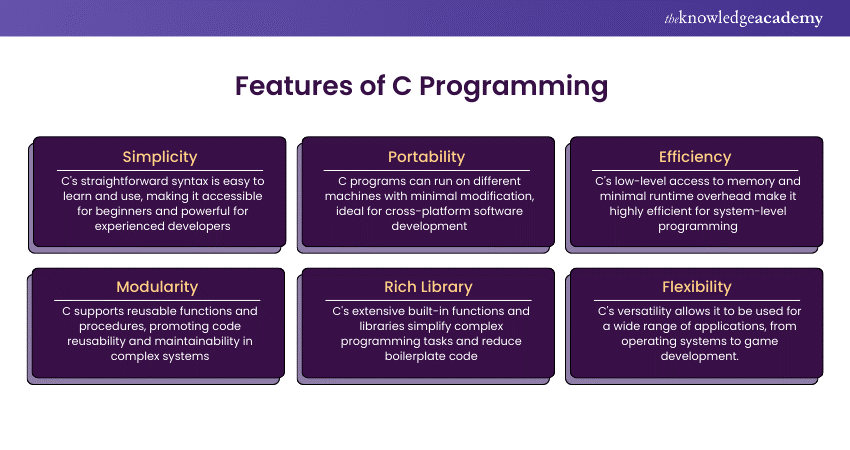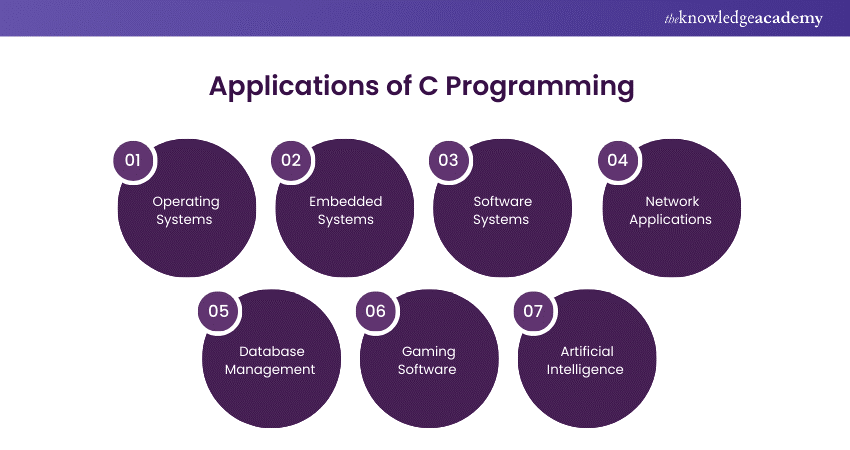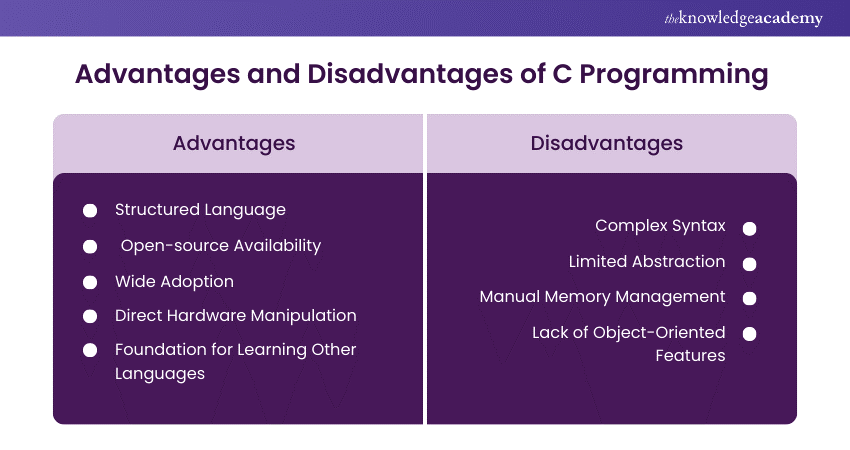We may not have the course you’re looking for. If you enquire or give us a call on +61 1-800-150644 and speak to our training experts, we may still be able to help with your training requirements.
Training Outcomes Within Your Budget!
We ensure quality, budget-alignment, and timely delivery by our expert instructors.

Ever wondered how the software you use daily is built from the ground up? The answer often lies in a language that's been around for decades yet remains incredibly relevant: C. What is C Programming? It's the foundational language that has shaped the digital world as we know it. From operating systems to embedded systems, C's influence is undeniable.
This comprehensive will explore What is C Programming, exploring its history, core concepts, and applications. Whether you're a budding programmer or a seasoned developer, understanding C will provide valuable insights into the heart of computer science. Let's dive in!
Table of Contents
1) What is C Programming?
2) The Evolution of C Programming
3) Features of C Programming
4) Applications of C Programming
5) Elements of a C Program
6) Advantages and Disadvantages of C Programming
7) Conclusion
What is C Programming?
C Programming is a high-level, multi-purpose programming language that excels in developing firmware and portable applications. Developed by Dennis Ritchie in the early 1970s, C offers low-level access to memory and a straightforward set of keywords. This combination of features makes C an ideal choice for system programming. Over the decades, C has become one of the most broadly used Programming Languages, influencing many modern languages such as C++, C#, and Java.
C Programming provides a balance between high-level abstraction and low-level control. Its syntax and semantics are simple enough for beginners to learn, yet powerful enough to write complex system software. This versatility and efficiency have cemented C's place as a fundamental programming language in computer science and software engineering.
The Evolution of C Programming
The history of C Programming dates back to the early 1970s when Dennis Ritchie and Brian Kernighan at Bell Labs sought to improve the B programming language. Their goal was to create a more efficient and flexible language for writing operating systems. The result was C, which quickly became the language of choice for system programming.
In 1978, the release of "The C Programming Language" by Kernighan and Ritchie, often referred to as K&R, standardised the language and contributed to its widespread adoption. The book provided a comprehensive guide to C and set the foundation for many of its conventions and practices.
Throughout the 1980s, C's influence grew with the development of Unix, which was rewritten in C. This move showcased C's capabilities and solidified its reputation as a powerful and efficient programming language. In 1989, the American National Standards Institute (ANSI) formalised C, creating the ANSI C standard. This standardisation ensured consistency and compatibility across different implementations of the language.
C has continued to evolve, incorporating new features and improvements while maintaining its core philosophy of simplicity and efficiency. The language has influenced many other programming languages, contributing to the development of C++, Objective-C, and many others.
Discover the power of C programming Training with our expert-led courses. Start learning and coding now!
Features of C Programming
C Programming is renowned for several features that contribute to its enduring popularity:

1) Simplicity
C has a straightforward syntax that is easy to learn and use. Its simplicity makes it accessible to beginners while providing powerful tools for experienced developers. The language's concise syntax allows for writing clear and readable code.
2) Portability
C programs can be executed on different machines with minimal or no modification. This portability makes C an ideal choice for developing cross-platform software. By adhering to the ANSI C standard, developers can ensure their programs run consistently on various systems.
3) Efficiency
C provides low-level access to memory and hardware, making it highly efficient for system-level programming. The language's minimal runtime overhead ensures that programs run quickly and use resources effectively. This efficiency is crucial for developing performance-critical applications such as operating systems and embedded systems.
4) Modularity
C supports functions and procedures, allowing code to be organised into reusable modules. This modularity promotes code reusability and maintainability, enabling developers to build complex systems from smaller, manageable components.
5) Rich Library
C has a rich set of built-in functions and libraries that simplify complex programming tasks. The Standard Library provides functions for input/output operations, string manipulation, memory management, and more. These libraries extend the language's capabilities and reduce the need for writing boilerplate code.
6) Flexibility
C can be used for a broad range of applications, from system software to game development. Its flexibility and power make it suitable for developing various types of software, including operating systems (OS), embedded systems, network applications, and more.
Master the fundamentals of coding—Join our C Programming Course today!
Applications of C Programming
C Programming's versatility makes it suitable for various applications across different domains. Here are some notable examples:

1) Operating Systems
C is the language preferred for developing operating systems (OS). Its low-level capabilities allow developers to interact directly with hardware components, making it suitable for writing efficient and fast operating systems. Unix, one of the earliest and most influential operating systems, was developed in C. Other operating systems (OS) like Linux, Windows, and MacOS have core components written in C. The language's efficiency and control over system resources are crucial for managing hardware and executing processes reliably.
2) Embedded Systems
Embedded systems are specialised computing systems that perform dedicated functions within larger systems. C is widely used in embedded programming because of its ability to directly manipulate hardware and its efficient use of resources. Examples of embedded systems programmed in C include automotive control systems, medical devices, consumer electronics, and industrial machines. The language's close-to-the-metal capabilities ensure that embedded systems operate with high performance and reliability, often in real-time environments.
3) Software Systems
C is used to develop various software systems, including compilers, interpreters, and utility programs. Its efficiency and control over system resources make it an amazing choice for building robust and high-performance software infrastructure. For example, many compilers and interpreters for other programming languages are written in C, leveraging its speed and reliability. Utility programs such as text editors, file managers, and system monitors also benefit from C's efficiency.
4) Network Applications
Networking software often requires efficient and reliable communication protocols. C's speed and low-level access make it suitable for developing network applications such as routers, switches, and firewalls. Many networking protocols and tools, including TCP/IP and network monitoring software, are implemented in C. The language's ability to handle low-level data manipulation and real-time processing is essential for developing robust and high-performance network applications.
5) Database Management
C is used to develop database management systems (DBMS) and related tools. Popular DBMS like MySQL and PostgreSQL have core components written in C. The language's efficiency and control over system resources ensure that database operations are fast and reliable. C's ability to handle large amounts of data and perform complex operations efficiently makes it ideal for database management.
6) Gaming Software
The gaming industry demands high performance and real-time processing. C provides the speed and efficiency required for developing complex game engines and graphics rendering systems. Many popular game engines including the Unreal Engine, have components written in C. The language's ability to handle low-level graphics operations and real-time processing is crucial for creating immersive and responsive gaming experiences.
7) Artificial Intelligence
While higher-level languages like Python are commonly used in AI research, C plays a crucial role in implementing performance-critical components. AI applications that need real-time processing, such as robotics and computer vision, often rely on C for optimised performance. The language's efficiency and control over system resources ensure that AI algorithms run quickly and reliably, making it suitable for developing high-performance AI applications.
Take your coding skills to the next level—Register for our C++ Programming Course today!
Elements of a C Program
A C program consists of several key elements that work together to perform tasks:
1) Header Files
Header files contain definitions of functions and macros that are used in the program. They are included at the beginning of the program using the #include directive. Common header files include stdio.h for standard input/output functions, stdlib.h for standard library functions, and string.h for string manipulation functions.
2) Main Function
The main() function is the starting point of a C program. Execution starts from the main() function. It typically contains the core logic of the program and calls other functions as needed. The main() function returns an integer value, which indicates the program's exit status.
3) Variables
Variables are used to store data that can be manipulated by the program. They are defined with a specific data type and can hold different values throughout the program's execution. Variables provide a way to store and manipulate information dynamically.
4) Data Types
C supports various data types, including int, float, char, and double, to define the type of data stored in variables. These Data Types allow for representing different kinds of information, such as integers, floating-point numbers, characters, and more.
5) Operators
C provides a broad range of operators for performing arithmetic, logical, and bitwise operations. Arithmetic operators include +, -, *, and /. Logical operators include && (logical AND) and || (logical OR). Bitwise operators include & (bitwise AND) and | (bitwise OR). Operators enable various computations and manipulations within the program.
6) Control Statements
Control statements like if, else, while, for, and switch are used to control the flow of the program. They allow for making decisions, repeating actions, and branching the program's execution based on certain conditions. Control statements provide the ability to create complex and dynamic behavior in the program.
7) Functions
Functions are blocks of code that execute specific tasks. They can be predefined or user-defined. Predefined functions, such as printf() and scanf(), are provided by the C standard library. User-defined functions allow developers to create reusable and modular code, improving the program's structure and maintainability.
8) Pointers
Pointers are variables that store memory addresses. They are used for dynamic memory allocation and manipulation of arrays and strings. Pointers provide a powerful way to work with memory directly, enabling efficient and flexible memory management.
Advantages and Disadvantages of C Programming

Advantages
a) Structured Language: C promotes structured programming through the use of functions and control structures. This encourages clear and organized code, making it easier to debug, maintain, and understand.
b) Wide Adoption: C has been widely adopted across industries for decades, leading to a vast ecosystem of tools, compilers, and resources. This extensive support makes development and troubleshooting easier.
c) Direct Hardware Manipulation: C allows direct manipulation of hardware resources, making it ideal for developing firmware and embedded systems where precise control over hardware is necessary.
d) Foundation for Learning Other Languages: Learning C offers a strong foundation for interpretating other programming languages, especially those derived from or influenced by C, such as C++, Java, and Python.
e) Open-source Availability: C's open-source nature and extensive documentation mean that there are numerous libraries, frameworks, and code examples available for free, facilitating learning and development.
Disadvantages
a) Complex Syntax: C's syntax can be complex and error-prone for beginners. The language requires careful attention to detail, and minor mistakes can result in significant issues, such as segmentation faults and undefined behavior.
b) Lack of Object-Oriented Features: C does not support object-oriented programming (OOP), making it less suitable for certain applications that benefit from OOP principles, such as inheritance, encapsulation, and polymorphism. Developers often turn to languages like C++ for OOP support.
c) Manual Memory Management: C requires manual memory management, which can lead to errors like memory leaks and buffer overflows. Developers must carefully allocate and deallocate memory, which can be challenging and error-prone.
d) Limited Abstraction: C provides limited abstraction compared to higher-level languages, requiring more detailed and low-level programming. This lack of abstraction can make code more complex and harder to maintain, especially for large projects.
Transform your career—Join our C# and .NET Training today and master the skills needed to build robust applications!
Conclusion
C Programming is a powerful and versatile language that has stood the test of time. Its efficiency, portability, and control over system resources make it an ideal choice for a broad collection of applications, from operating systems (OS) and embedded systems to gaming software and artificial intelligence (AI). Understanding the elements and features of C Programming provides a strong foundation for any programmer, paving the way for mastering more complex languages and systems.
Frequently Asked Questions

C does not have a full form; it is named "C" because it is the successor to the B programming language, which was itself derived from an earlier language called BCPL.

A compiler in C translates C code into machine code or executable programs. It checks for syntax errors and converts the high-level code into a format that the computer's processor can execute.

A loop in C is a control structure that recurrently executes a block of code as long as a specified condition is met. Common loops include for, while, and do-while.

The Knowledge Academy takes global learning to new heights, offering over 30,000 online courses across 490+ locations in 220 countries. This expansive reach ensures accessibility and convenience for learners worldwide.
Alongside our diverse Online Course Catalogue, encompassing 17 major categories, we go the extra mile by providing a plethora of free educational Online Resources like News updates, Blogs, videos, webinars, and interview questions. Tailoring learning experiences further, professionals can maximise value with customisable Course Bundles of TKA.

The Knowledge Academy’s Knowledge Pass, a prepaid voucher, adds another layer of flexibility, allowing course bookings over a 12-month period. Join us on a journey where education knows no bounds.

The Knowledge Academy offers various C Programming Courses, including the E C# Programming Course, C Programming Course and the C++ Programming Training. These courses cater to different skill levels, providing comprehensive insights into C vs Java.
Our Programming and DevOps Blogs cover a range of topics related to C Programming, offering valuable resources, best practices, and industry insights. Whether you are a beginner or looking to advance your Programming skills, The Knowledge Academy's diverse courses and informative blogs have got you covered.
Upcoming Programming & DevOps Resources Batches & Dates
Date
 C Programming
C Programming
Thu 16th Jan 2025
Thu 6th Mar 2025
Thu 22nd May 2025
Thu 24th Jul 2025
Thu 25th Sep 2025
Thu 20th Nov 2025
Thu 11th Dec 2025







 Top Rated Course
Top Rated Course



 If you wish to make any changes to your course, please
If you wish to make any changes to your course, please


